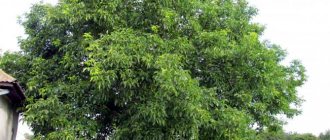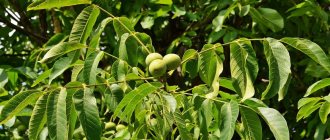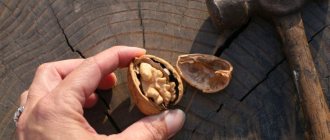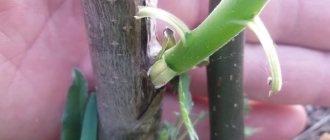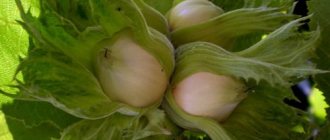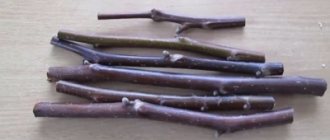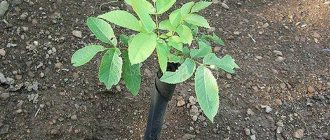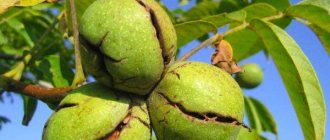Business relevance
Growing walnuts is a highly profitable business that does not require significant capital for development. As practice shows, seedlings quickly take root after planting, tolerate temperature fluctuations and are resistant to various pests. The process of caring for trees is simple, and harvesting (and profit) is guaranteed for many decades. Therefore, by organizing the cultivation of walnuts as a business, you can provide not only income for yourself, but also leave a good inheritance for your children and even grandchildren.
But this coin also has a flip side - the business idea will not begin to generate income immediately, but after 8-10 years. The first harvest will be possible after at least 5 years. The time required to accumulate capital and pay back the project belongs to the “long-term money” program, and the project itself is not without risks. This branch of agricultural production is recommended for specialized farms as an additional source of direction.
Subtleties of care and ripening time
Manchurian walnut is an unpretentious crop. This is a fairly strong plant, capable of developing and bearing fruit without human intervention. Still, if you want the tree to be healthy and enjoy high productivity, additional care will not hurt it.
Watering
The plant has a deep root system, so it is able to tolerate a temporary lack of moisture, but for the first year after planting it is necessary to maintain constant soil moisture. Waterlogging of the top layer of soil also does not become an obstacle to the development of nuts, but provided that the soil is first well drained.
Properties
An important advantage of this business is the constant stable demand, which is due to:
- the value of the nut as a food product;
- possibility of transportation over long distances;
- good product safety;
- deficit in Russia and European countries.
The yield of such gardens can reach 2.5 tons of peeled kernel per hectare. The size of the nut kernel varies within 35 mm. When assessing the yield and quality of products, the following is taken into account:
- taste (no bitterness);
- core size;
- shell wall thickness;
- degree of filling of the nut kernel;
- ease of removing the kernel from the shell.
Variety selection
Today, breeders have developed many different varieties of walnuts, each of which has its own qualities.
Let's consider varieties that are suitable for organizing a profitable and profitable business:
- "Bulganak" - produces a harvest 5-6 years after planting and proper processing. The crown of the tree is of medium density, the core is quite large - 12-14 grams. 5 years after planting, about 2.5 centners of nut kernels can be collected from one hectare; after 20 years, the yield will increase to 36 centners.
- “Ideal” is a real victory and pride for breeders and a great opportunity to make money for entrepreneurs. The variety has excellent performance - after 20 years, about 120 kilograms of crop can be harvested from one tree, the tree begins to bear fruit in the third year. The kernel occupies 50.1% of the mass of the entire nut, the shell is thin, and the taste is excellent.
- “Burliuk” is an unpretentious variety of nuts that begins to bear fruit in 6-7 years. The crown of the tree is round, the average kernel weight is 12 grams. 7 years after planting, 3 centners of kernels can be collected from one hectare; at 20 years of age, trees yield up to 41 centners.
- “Giant” ripens late, but the yield is quite high, which can reach up to 30 centners per hectare. The tree begins to bear fruit at 5-6 years. The nut received this name due to its large size: on average, the kernel reaches 30 grams, while the thickness of the shell remains only 1 millimeter.
- Arkad - at the age of seven gives a yield of about 2.7 centners per hectare, at the age of 20 the yield increases to 46 centners. The tree will bear fruit in the seventh year. The crown is wide and rounded, the skeletal branches are located at an acute angle. The mass of the core is about 10 grams.
Walnut care
In the south, close attention is paid only to young trees. In other regions, the crop needs to be looked after constantly.
Watering and fertilizing
Walnut is a crop that requires sufficient, but not excessive moisture. It needs the greatest amount of moisture in spring and the first half of summer, when green mass is growing and fruits are forming. In the second half of summer and autumn, excessive watering or frequent rains can damage the tree. But recharging the moisture before retiring is a mandatory procedure, otherwise it will freeze or not survive the winter at all.
In short, you should pay attention to the following points:
- In the south, adult walnuts growing on black soils do not need to be fed. Once every 4 years, the tree trunk circle is mulched with humus.
- In other regions, the tree is fertilized with nitrogen in early spring, and with phosphorus and potassium in the second half of summer. Before winter, humus is added to the tree trunk circle.
Trimming and shaping
Often the walnut crown is not formed at all; at best, one trunk is removed if a fork has formed on the central conductor. But to improve fruiting, especially on varieties with densely growing branches, pruning is necessary.
When forming the crown, it is recommended to set the height of the trunk at 80-90 cm. This will make it easier to harvest and care for the tree. For all varieties it is better to leave one central conductor.
The crown should maintain its natural shape, the branches should be thinned out to improve the lighting of the tree. The further north the site is, the greater the distance left between the skeletal shoots. For example, in the southernmost regions, the uterine branches can be 25-30 cm apart from each other, closer to the middle zone - 40 cm.
If the walnut crown is sparse and well lit, pruning involves preventing the formation of forks located at an acute angle. Every year, remove all dried and frozen ends of the shoots in winter or spring.
Protection from diseases and pests
Nuts growing in well-lit and ventilated areas that are properly cared for rarely get sick or are affected by pests. This is largely due to the fact that the phytoncides secreted by the crop have a detrimental effect on pathological microorganisms, and the specific smell repels insects.
Comment! Most often, walnut trees are affected in Central Asia.
The crop is affected by brown spot, which should be combated by spraying with copper-containing preparations. Before the leaves bloom and after they fall off, fungicides are used in strong concentrations, for example, 2-3% Bordeaux mixture. During the growing season, the solution is made at 1%. Usually 2-3 treatments are enough.
Sooty fungus can settle on walnuts. True, it causes little inconvenience to the culture itself, but it affects plants growing nearby quite severely.
Among the pests it is necessary to highlight:
- aphids;
- moth;
- ticks;
- nut borer;
- urban barbel;
- nut moth.
It is better to combat them using biological methods, for example, spraying them with a solution of green soap or tobacco infusion. Only if these measures are unsuccessful, insecticides are used.
Preparing for winter
Only young nuts can be covered for the winter. Very quickly the trees become so large that they cannot be placed in a special tube or wrapped in agrofibre. All that remains is to carry out measures that increase resistance to frost:
- form trees with one conductor (trunk);
- reduce watering in the second half of summer;
- mulch the tree trunk circle with humus;
- feed at the end of summer or beginning of autumn with phosphorus-potassium fertilizers;
- whiten the trunk and skeletal branches for the winter.
Growing technology
The tree is thermophilic, but can tolerate frosts down to -25 ºС - -30 ºС, and grows in regions with a temperate climate. Beginning entrepreneurs need to know how to grow walnuts, all the intricacies of fertilizing and caring for trees. Main factors and growing technologies:
- The influence of light. Walnut is a light-loving crop that will grow well and produce a high yield only in good light. But do not try to plant trees densely to increase yield - such attempts have never been successful.
- Humidity. The best option is to grow in regions with low humidity and a constant groundwater level. It is unacceptable to plant trees in acidic soil or in marshy areas.
- The soil. Good results can only be obtained if all agricultural measures are fully implemented.
- Fertilizers. It is recommended to apply potassium-phosphorus fertilizers at the root level. There is no need to loosen the soil many times. Nitrogen fertilizers will increase yields, but can also contribute to the development of bacteriosis, so they should be treated with caution.
- Irrigation. Nuts require high water intake, especially from May to August. In many regions, precipitation levels are insufficient, so it is advisable to water the crop.
Video - Planting walnuts in open ground:
Is it possible to grow a walnut from a nut?
For many centuries, walnuts were propagated only by seeds. Varieties are created exclusively by selection and acclimatization, so cultivated trees are not very different from their wild relatives in biological terms. Cross-pollination with other species is possible, but has not yet produced noteworthy results.
So trees grown from nuts may not be identical to the original variety. But they usually produce large, tasty fruits and grow well in the region where the mother tree comes from.
Choosing planting methods
Planting nuts can be done in two ways - seedlings or seeds. But in the latter case, it is not always possible to predict what fruits the tree will bear and whether the variety is compatible with the selected region. The only exceptions can be specialized companies that breed and sell nut seedlings.
If nuts are already growing near the selected area for planting trees, you can choose this plant as a seed donor. This will give you confidence in adapting to the climatic conditions and soil conditions of the selected region.
How to plant nuts from seeds: Collect the largest and ripest fruits. An indicator of ripeness is small cracks in the outer shell and simple peeling of the shell. It is recommended to plant in the fall after harvesting.
Dig a hole 1 meter deep, peel the nut from the outer shell (pericarp) and place it in it, covering it with soil and humus. There is much debate about whether the pericarp of a nut should be peeled. It has been proven that when they are cleaned, the tree germinates faster.
It is better to plant seedlings in early spring at 2 years of age. Choose seedlings whose trunk thickness is at least 1 centimeter at a distance of 5 centimeters from the root collar. The height of the sprout is not important. Before planting, the vertical root must be cut off by 2-3 centimeters, and the cut area should be lubricated with clay. The seedling is placed in a dug hole and covered with fertilized soil, excess branches are cut off. growing walnuts
Financial plan
Let's consider approximate calculations for planting 100 hectares. 68 seedlings are needed for 1 hectare.
- site preparation (cultivation, plowing) – 40 thousand rubles;
- preparation of planting holes (digging, fertilizing) – 300 thousand rubles;
- purchase of seedlings (6800 pieces, two-year-old, cost of one - 300 rubles) - 2.04 million rubles;
- care (planting, tying to the base, watering) – 500 thousand rubles;
- costs for agrochemicals (maximarin, superphosphate) – 500 thousand rubles;
- wage fund (4 workers for 10 months with a salary of 18,000 rubles) – 720 thousand rubles;
- other costs (tax, transport, etc.) – 100 thousand rubles.
As can be seen from the approximate business plan, in the first year costs of 4.2 million rubles are needed.
The cost of maintaining the garden in future years will be about 1,820,000 rubles. They will be used for plowing, removing weeds, applying agrochemicals, watering and protecting the territory.
Approximate calculation: 4.2 million rubles. + 1.82 million rub. x 4 years = 11.48 million rubles.
Balance for five years – -11.48 million rubles. Video - Industrial cultivation of nuts (automation):
Profitability calculation
How much can you earn? You can count on making a profit only starting from the fifth year. You can collect approximately 640 centners of nuts from 100 hectares of land.
The cost of a peeled nut is 250-600 rubles per kilogram (depending on the condition of the kernel), prices for unshelled nuts vary between 130-150 rubles per kilogram.
If you hire 4 more temporary workers to collect and process nuts (their wages for two months will be 144 thousand rubles) and sell unshelled nuts at 140 rubles per kilogram, the income will be 8.96 million rubles. (64000 kg x 140 rub.).
Approximate net profit - 6,996,000 rubles. (8.96 million rubles – 1.82 million rubles – 144 thousand rubles).
As can be seen from the calculations, in three years you can recoup the start-up costs and reach the break-even point in the 8th year.
At the same time, the yield will increase every year. Already in the tenth year, with proper garden maintenance, up to 80 tons of nuts can be collected from 100 hectares.
To increase business efficiency, you can purchase a nut processing line and sell it already peeled.
Required starting capital: from 11,480,000 rubles. Monthly profit: from 583,000 rubles (6,996,000 million rubles per season, starting from the 5th year) Payback period: from 8 years.
Sales
Today, in Europe and Russia there is a fairly large shortage of walnuts. There is no need to advertise the products; during the season, nut buying points are opened in the markets. You can often meet a person with a sign “I’ll buy nuts.” You can also search for advertisements on the Internet.
Industrial cultivation of nuts can be called “passive income”, and besides, the business is designed for more than one generation.
Possibility of combining with another type of business
Since the trees are planted sparsely, other crops can be grown between them for a more rational use of the land (this direction is especially important in the first five years, when the seedlings grow). You can grow pumpkin or legumes.
Walnuts are heat-loving and common in the southern regions. Attempts to grow them in the north ended in failure. But residents of the northwestern regions can replace it with Manchurian walnut, which is very similar to walnuts, but is frost-resistant (can withstand cold winters from -30ºС and even short drops down to -45 ºС).
Also, as a combination of directions, you can grow chekalkin nut - this is a shrub up to 4 meters high. It has a curved crown that is covered in white flowers in spring. Experts consider this plant one of the most beautiful shrubs. Then the flower turns into a small box, in each of which by autumn 5-17 hazelnut-like nuts are formed.
Does Manchurian walnut grow in the Urals?
The birthplace of the nut is considered to be China, namely the Manchurian region of the country, from where the plant got its name. In nature, it also grows on the Korean Peninsula and the Far East. Thanks to high frost resistance and easy adaptation to weather conditions, the crop can be grown in any climate zone, including the Urals.
It is also worth noting that Manchurian walnut has a wide range of applications . The kernels are eaten, an excellent oil is obtained from them for the confectionery industry, and they are also used in folk medicine. Infusions and decoctions are prepared from their nuts, which help in the treatment of diseases such as anemia, gastritis, diabetes, varicose veins, blood pressure disorders, etc.
Did you know? Manchurian walnut
-
long-lived: the tree lives up to 250 years.
It grows at a rapid pace for the first 80 years, reaching a height of up to 25 m, then the development process slows down. In addition to being grown in private households, the crop is widely used for landscaping city streets, due to its wide round shape with large leaves, clearly visible in the photo. By the way, nut shells are often used in applied arts, and high-quality plywood and furniture are made from wood with a beautiful texture.
